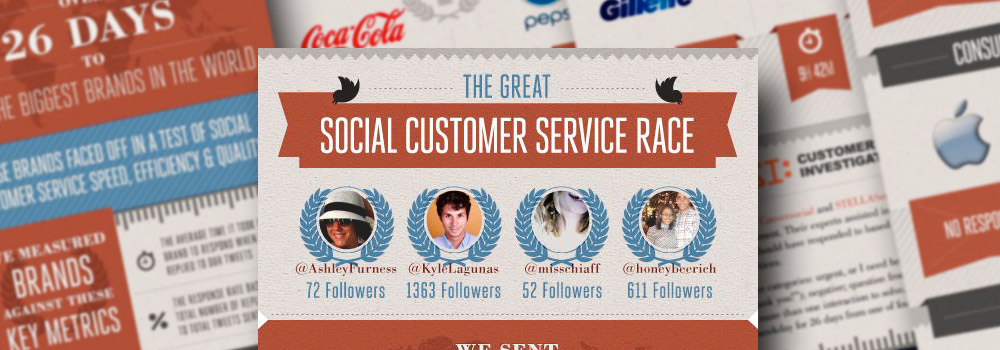It’s one thing to have your company active on social media channels. But it’s something else for your company to actually be ‘social’.
Probably the most common social media mistake made by companies is talking to people, instead of talking with them. Social media channels give companies a fantastic opportunity to build real and useful relationships with customers, prospects and influencers. Why would you want to waste that by blasting out marketing spiel or corporate rhetoric that (if we’re honest) no-one really believes anyway?
You might expect that large brands, with their (comparatively) bottomless resources and access to the best thinkers and best-practice advisors, would be the last place you’d look for bad examples social media channel use. Right?
Well, that was the basic reasoning behind a piece of research conducted by analyst Ashley Verrill, from Software Advice.
Trial By Tweet
The 5-week research project, called “The Great Social Customer Service Race”, involved using a particular social media channel – Twitter, in this case – and contacting 14 high-profile consumer brands once a day for four consecutive weeks. The tweets were loosely directed to the customer services departments of the brands, and ranged from the “Help, I need someone to sort this out for me ASAP” type of request, through to complaints, down to technical questions that might need a couple of exchanges to solve the issue.The researchers gave out points based upon how fast the brands got back to people, the quality of the response, and the percentage of tweets that initiated replies.
Social Media is called “Social” For A Reason
As is increasingly common nowadays, the research results have been made into an infographic (not my favorite way of presenting data, but there you go). Click here to to read more about the study.The verdict? Just because you’re a gazillion dollar multinational doesn’t mean that you ‘get’ social media any more than a “one man and his dog” sole trader who’s been in business for the past five minutes.
Ashley picked out a number of observations and social media best-practices that she feels we all could take on board to improve social response for service-directed enquiries:
- Listen for Brand Name With or Without the “@”
Less than 8% of responses came when an @ was not used in the tweet. The failure of brands to respond to negative, positive or other important tweets leaves a bad impression on the customer and anyone who follows them. - Important Keyword Triggers are Your Friend
When designing questions for the research, Ashley’s team specifically included questions with important intent, sentiment or risk of switching brands. Social listening software can be programmed to send service messages to the front of the line if they contain keywords such as “help,” “mad,” or “thank you” to help with prioritization. - Keep the Customer Informed
Coca-Cola and McDonald’s committed huge errors when two of their replies came several days after the questions were sent. For the instant-gratification customer, this is seen as being the same as not responding at all. One way companies can streamline social customer service is by integrating listening software with helpdesk ticketing programs. - Capitalize on Customer Service for Marketing
Social should not be separated exclusively in marketing, or community management or customer service. MasterCard earned special recognition by capitalizing on an opportunity to market a customer service interaction. When one of the Software Advice analysts asked whether the credit card is accepted globally, the MasterCard team responded and re-tweeted her message. In another instance, MasterCard used the customer service opportunity to pitch a new product.
The Rules Are That There Are No Rules
The very fact that Ashley and her team put these together, and that brands who you’d think would know better didn’t pass muster, is actually pretty great news.The research seems to show that, in many ways, this whole online interaction and audience engagement thing is still in the Wild West stages. It means that the companies that get it right aren’t necessary the ones who’ve been doing it the longest, or the ones with the largest resources – or the deepest pockets.
It means that your business can be as good as theirs, if not quite a bit better.

